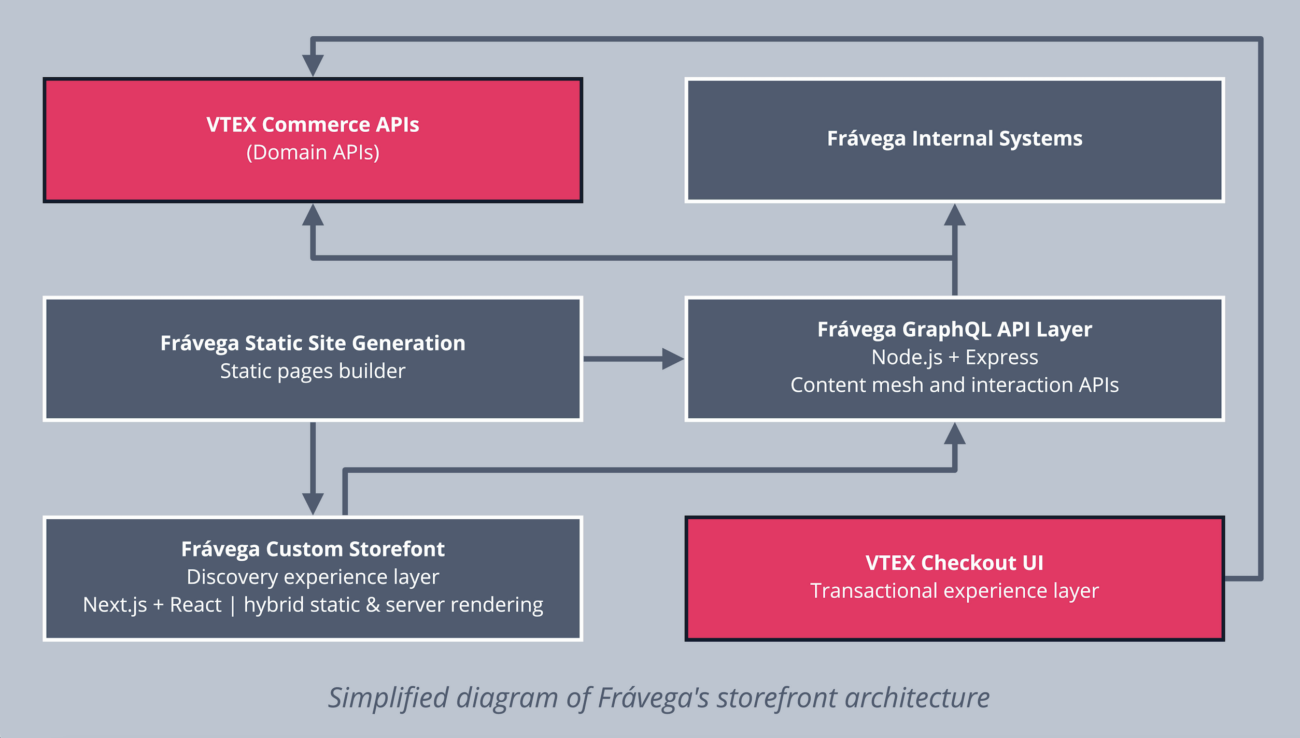
Frávega, a VTEX customer since 2014, is an Argentinian retail chain with 110 branches and over 2,700 employees. Its main profile has always been electronics & home appliances. However, in the past years, as it opened its marketplace, it has started offering products across various other verticals via third-party sellers. Currently, Frávega has over 80,000 SKUs.
As a 100-year old company with a strong track record in technology, Frávega naturally has an accumulation of systems created for specific purposes. Just like at any other company, the unification of these so-called Legacy systems is quite a challenge, but it is absolutely necessary to overcome this complexity in order to guarantee a seamless and unified customer experience. This is where VTEX, with its composable commerce offering powered by Amazon Web Services (AWS), provides a true helping hand.
Frávega’s mindset
Previously, we talked extensively about Frávega’s use of composable commerce and the mindset behind that strategy, but a reminder is worthwhile. Frávega has a very strong, knowledgeable and professional team of over 100 people handling everything related to digital commerce and IT operations, similar to an innovation lab. They are structured in three sub-areas: research & development, sales and post-sales. This team is in charge of internal solution development.
However, the goal is not to build everything; instead, Frávega has a hybrid approach in which it builds what is unique for its business and integrates them into outsourced systems. Before starting to develop a solution, all projects are assessed according to well-defined criteria, like time-to-market, difficulty of implementation, impact on the ecosystem and operations, short-term and long-term costs of maintenance.
Ultimately, anything that Frávega builds internally is meant to strengthen the retailer’s omnichannel strategy and to bring value to all of its sales channels.
Frávega’s Challenges

Marketplace
Becoming a marketplace was a major milestone in Frávega’s journey towards expanding its market share. The company needed a solid solution that would incorporate over 100 sellers seamlessly and efficiently.
With VTEX as an ecommerce platform, Frávega could onboard new digital operations using its seller portal and integrate with other sellers from the VTEX ecosystem, not to mention integrate into large ecommerce operations, like Mercado Libre, using VTEX pre-built integrations. Additionally, it could even create custom integrations to specific sellers on top of an integration protocol.
Now, not only does Frávega sell goods from a wide range of partners in various verticals, but many of its clients sell online exclusively via Frávega’s marketplace model. They are essentially lifted into the online commerce space by Frávega’s marketplace.
Checkout (Transaction Layer)
Frávega needed a PCI-compliant and frictionless checkout solution, built for conversion. Moreover, Argentina’s complex market required many functionalities catering to its numerous payment methods, the culture of paying in installments and different payment plans according to the credit card label and bank.
The VTEX SmartCheckout tackled these issues effectively. It had the desired payment integrations, configurations and security, with a no-password-required checkout focused on conversion. For Frávega, there was no longer a need to develop a solution of its own.
Storefront (Discovery Layer)
Needing arguably the most customization out of all of Frávega’s operations, the storefront required a range of functionalities such as customer location, integration with an internal stores system for pick-up in-store, pricing and availability that varies according to the buyers’ region, among other tailored rules and business logic.
Creating a unique experience layer for its consumers that abstracts the back-office complexity is very important for a user experience in today’s competitive commerce environment. Frávega needed to have full control over the UX of its digital channels and needed to have them being executed with maximum performance, as it’s known that performance is directly related to the conversion rate.
The answer here was an in-house solution, based on open source technology, that takes advantage of a Static Site Generation approach. This is the subject that we are going to analyse next in a deeper manner.
The design and implementation of the solution

Leveraging the advantages of VTEX’s MACH architecture (more on that soon) and with a strong in-house technical team, Frávega chose to create its very own storefront implementation, based on cutting-edge technology. Since then, it has cherished the benefits of a flexible commerce platform that enables it to join robust out-of-the-box features with highly efficient custom-made components.
As its main objective was to create a unique and high-performing discovery experience, it implemented its custom solution for the home page, landing pages, categories, search, as well as product page, but kept the VTEX standard storefront solution throughout the transactional phase of the customer journey (i.e. cart and checkout).
This kind of hybrid implementation works seamlessly since Frávega has used VTEX as its core commerce engine. As a result, the custom-built discovery layer is in constant connection with the VTEX Commerce APIs.
In an effort to create a unique digital experience for its customers, with great performance but also unifying data from different sources, Frávega has created its very own GraphQL API layer, that connects with VTEX Commerce APIs and also with third-party APIs, offering a unique entry point to the storefront to get data.
The custom-built solution on the storefront is using state-of-the-art technologies and paradigms of the modern web. It’s a React and Next.js-based solution with a hybrid static & server rendering strategy, completely optimized for search engines.
VTEX as MACH
The MACH Alliance presents and advocates an open and best-of-breed enterprise technology ecosystem. The ecosystem technology is: Microservices-based, API-first, Cloud-native SaaS and Headless.
Let’s take them one by one and see how each component helped Frávega grow.
- Frávega prefers to use some functionalities provided by VTEX while others come from either in-house or third-party solutions. Thanks to VTEX’s Microservice-based architecture, cherry-picking modules and features was easy and Frávega could address its unique challenges with the best solution.
- Thanks to VTEX’s API-first approach, Frávega’s VTEX components integrate smoothly with those developed internally or by third-party providers.
- Frávega fully leverages VTEX’s Cloud-native architecture, which guarantees real-time auto-scaling in reaction to fluctuations in web traffic.
- In traditional ecommerce, you would either develop in-house or leave your entire operation to a single provider. Most commonly, the former would enable a tailored solution, but at a higher cost. The latter might prove to be more economical but you may find that none of the solutions already available can attend to all your requirements. Thanks to Headless designs, you no longer have to make this compromise. For many years, Frávega’s experience with a headless commerce platform has shown that its efficiency is highest when getting the best of both worlds: its highly customized in-house features integrate smoothly with those they have readily available from VTEX.
Frávega, like plenty of other enterprise retailers, has adopted a composable approach in order to optimize and streamline a complex business process. You could do the same, should you wish it, with VTEX.











